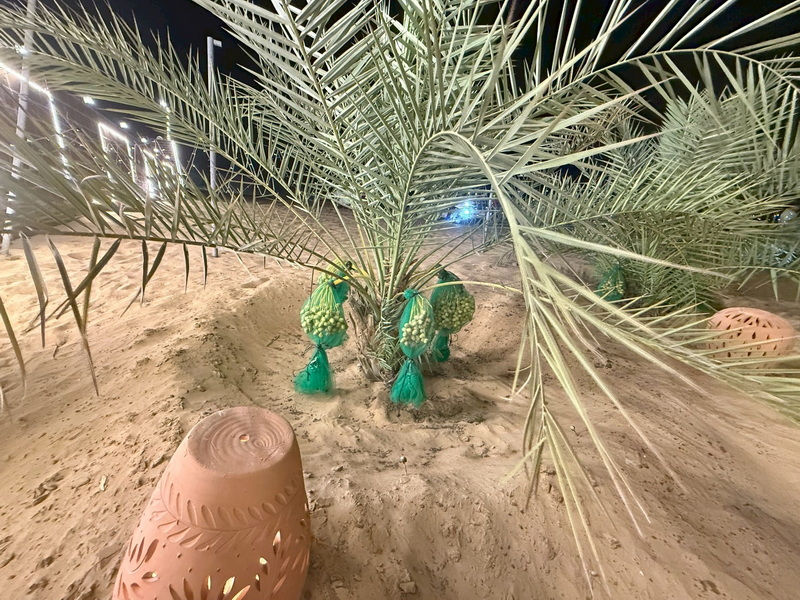One Thousand and One Nights in Dubai Bay
- ST

- Jul 14
- 8 min read
Updated: Aug 5

Dubai Creek, also known as Dubai Creek, is a naturally formed narrow bay that divides the city of Dubai in two. It is the starting point of the city's development. In the past, it was an important port for pearling and fishing in Dubai, but now it has been transformed into a tourist attraction, blending traditional and modern features.
The river plays an important role in Dubai's history, promoting trade with India and Africa in the past and providing a safe port for merchant ships. There are many ways to cruise the river. You can choose a traditional abra, which is also a water taxi. It is cheaper to take an electric abra to cruise the river, which is also a common mode of transportation for many local workers to commute across the river.

There are many abra stops along the river, and boats depart every few minutes every day during the week. The boat will depart when there are about 20 passengers on board. There is no need to purchase a ticket in advance, just pay on the boat.

You will find that the architectural styles on both sides of the Dubai Creek are very different. Burin Dubai is the old city with traditional Middle Eastern architectural features. Deira Dubai is more modern and has many skyscrapers. Take a walk along the riverside promenade to appreciate the characteristics of these two areas. These paved promenades are quite beautiful and fully illuminated, which is very pleasant to stroll here at night.
Dubai's modern luxury impression is so strong that people often forget their native local culture. Therefore, a trip to Dubai's old city will make you feel the real charm of Dubai! When it comes to Dubai's old city, it is basically the area on both sides of the Dubai Creek, Deira in the north and Bur Dubai in the south. Because Dubai Creek used to be the location of a pearl fishing village and the center of Dubai's early economic and trade development.


Dubai Desert offers a variety of outdoor activities, such as dune sledding, sand sliding, camel riding, etc., which attract a large number of tourists to experience the desert style. In the evening, you can watch belly dancing and eat barbecue.

The date palm tree was long extinct until scientists revived it by germinating 2,000-year-old seeds. The seeds were found in an ancient jar in Israel and dated between 155 BC and 64 AD.
The date palm fruit is an important food source in many regions, rich in sugars, fiber, and many vitamins and minerals. Other parts of the tree are also used for building materials, fuel, and handicrafts.
Dubai's food culture is diverse and rich, blending the flavors of the Middle East, Arabia and around the world. The meals in the picture include kebabs, pasta and salads, which are common types of meals in Dubai, especially kebabs, which are one of the representatives of Middle Eastern cuisine.
▲ XTRA Arabic series of porcelain pots and cups (hot-selling products in the Middle East)

"One Thousand and One Nights", also known as "Arabian Nights", is a famous literary work of ancient Arabia. It is also a shining flower of Arab people's contribution to the world's literary garden. For centuries, almost everyone in the world, young and old, knows it. "One Thousand and One Nights" has a wide variety of stories and colorful. In addition to various gods, demons and spirits, the characters involved almost all social classes and professions, such as emperors, generals, princes and princesses, merchants, fishermen, tailors, monks, peddlers, craftsmen, artists, slaves and maids... everything is included. Most stories have magical colors. Demons fly in the sky, flying carpets gallop between mountains and forests, omnipotent monsters burst out of magic lamps and magic rings, and land residents travel in the magical underwater world; the world is treacherous and ever-changing, and a series of dazzling and magnificent pictures come into view.

The main frame story concerns Shahryār, a king who ruled an empire that stretched from Persia to India. Shahryār is shocked to learn that his brother's wife is unfaithful. Discovering that his own wife's infidelity has been even more flagrant, he has her killed. In his bitterness and grief, he decides that all women are the same. Shahryār begins to marry a succession of virgins only to execute each one the next morning, before she has a chance to dishonor him.
Eventually the Vizier (Wazir), whose duty it is to provide them, cannot find any more virgins. Scheherazade, the vizier's daughter, offers herself as the next bride and her father reluctantly agrees. On the night of their marriage, Scheherazade begins to tell the king a tale, but does not end it. The king, curious about how the story ends, is thus forced to postpone her execution in order to hear the conclusion. The next night, as soon as she finishes the tale, she begins another one, and the king, eager to hear the conclusion of that tale as well, postpones her execution once again. This goes on for one thousand and one nights, hence the name.

The tales vary widely: they include historical tales, love stories, tragedies, comedies, poems, burlesques, and various forms of erotica. Numerous stories depict jinn, ghouls, ape people, sorcerers, magicians, and legendary places, which are often intermingled with real people and geography, not always rationally. Common protagonists include the historical Abbasid caliph Harun al-Rashid, his Grand Vizier, Jafar al-Barmaki, and the famous poet Abu Nuwas, despite the fact that these figures lived some 200 years after the fall of the Sassanid Empire, in which the frame tale of Scheherazade is set. Sometimes a character in Scheherazade's tale will begin telling other characters a story of their own, and that story may have another one told within it, resulting in a richly layered narrative texture.
When you read "The Story of Sinbad the Navigator", "Aladdin and the Magic Lamp", "Ali Baba and the Forty Thieves" and other stories, it seems that the whole world has quieted down, and this charming style makes you unforgettable for a lifetime? Yes, after seven or eight centuries of inheritance, "One Thousand and One Nights" still deeply touches the hearts of readers all over the world. Its language is simple and popular, the content of the story is interesting, and the layout is magical. It has a positive significance in arousing people's joyful spiritual level.
Story: Alibaba and the Forty Thieves

Ali Baba and his older brother, Cassim (Arabic: قاسم Qāsim, sometimes spelled Kasim), are the sons of a merchant. After their father's death, the greedy Cassim marries a wealthy woman and becomes well-to-do, living lazily on their father's business and his wife’s wealth. Ali Baba marries a poor woman and settles into the trade of a woodcutter. Cassim and his wife resent Ali Baba and his side of the family and do not share their wealth with them.
One day, Ali Baba is at work collecting and cutting firewood in the forest, when he happens to overhear a group of forty thieves visiting their stored treasure. The treasure is in a cave, the mouth of which is sealed by a huge rock. It opens on the magic words "open sesame" and seals itself on the words "close sesame". When the thieves are gone, Ali Baba enters the cave himself and although there is a vast amount of riches stashed inside, he modestly takes only a single bag of gold coins home.
Ali Baba and his wife borrow his sister-in-law's scales to weigh their new wealth. Unbeknownst to them, Cassim's wife puts a blob of wax in the scales to find out what Ali Baba is using them for, as she is curious to know what kind of grain her impoverished brother-in-law needs to measure.
To her shock, she finds a gold coin sticking to the scales and tells her husband. Under pressure from his brother, Ali Baba is forced to reveal the secret of the cave. Cassim goes to the cave, taking a donkey with him to take as much treasure as possible. He enters the cave with the magic words. However, in his excited greed over the treasure, he forgets the words to get out again and ends up trapped. The thieves find him there and kill him. When his brother does not come back, Ali Baba goes to the cave to look for him, and finds the body quartered and with each piece displayed just inside the cave's entrance, as a warning to anyone else who might try to enter.
Ali Baba brings the corpse home where he entrusts Morgiana (Arabic: مرجانة Murjāna), a clever slave-girl from Cassim's household, with the task of making others believe that Cassim has died a natural death. First, Morgiana purchases medicines from an apothecary, telling him that Cassim is gravely ill. Then, she finds an old tailor known as Baba Mustafa whom she pays, blindfolds, and leads to Cassim's house. There, overnight, the tailor stitches the pieces of Cassim's body back together. Ali Baba and his family are able to give Cassim a proper burial without anyone suspecting anything. Cassim’s wife does not find out about the cave or treasure.
The thieves, finding the body gone, realize that another person must have known their secret, so they set out to track him down. One of the thieves goes down to the town and comes across Baba Mustafa, who mentions that he has just sewn the pieces of a corpse back together. Realizing the dead man must have been the thieves' victim, the thief asks Baba Mustafa to lead the way to the house where the deed was performed. The tailor is blindfolded again, and in this state he is able to retrace his steps and find the house.
The thief marks the door with a symbol so the other thieves can come back that night and kill everyone in the house. However, the thief has been seen by Morgiana who, loyal to her master, foils the thief's plan by marking all the houses in the neighborhood similarly. When the 40 thieves return that night, they cannot identify the correct house, and their leader kills the unsuccessful thief in a furious rage. The next day, another thief revisits Baba Mustafa and tries again. Only this time, a chunk is chipped out of the stone step at Ali Baba's front door. Again, Morgiana foils the plan by making similar chips in all the other doorsteps, and the second thief is killed for his failure as well. At last, the leader of the thieves goes and looks himself. This time, he memorizes every detail he can of the exterior of Ali Baba's house.
The leader of the thieves pretends to be an oil merchant in need of Ali Baba's hospitality, bringing with him mules loaded with 38 oil jars, one filled with oil, the other 37 hiding the other remaining thieves. Once Ali Baba is asleep, the thieves plan to kill him. Again, Morgiana discovers and foils the plan when her lamp runs out of oil and she has to get it from the merchant's jars; the thieves give themselves away one by one hearing her approach and mistaking her for their boss. After refilling her lamp, Morgiana kills the 37 thieves in their jars by pouring boiling oil on them one by one. When their leader comes to rouse his men, he discovers they are all dead and escapes. The next morning, Morgiana tells Ali Baba about the thieves in the jars. They bury them, and Ali Baba shows his gratitude by giving Morgiana her freedom. However, she continues living with Ali Baba and his family anyway.
To exact revenge, the leader of the thieves establishes himself as a merchant, befriends Ali Baba's son (who is now in charge of his late uncle Cassim's business), and is invited to dinner at Ali Baba's house. However, the thief is recognized by Morgiana, who performs a sword dance with a dagger for the diners and plunges it into the thief's heart, when he is off his guard. Ali Baba is at first angry with Morgiana, but when he finds out the thief wanted to kill him, he is extremely grateful and rewards Morgiana by marrying her to his son. Ali Baba is then left as the only one knowing the secret of the treasure in the cave and how to access it.
















Comments